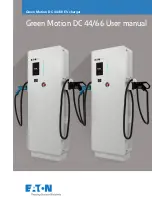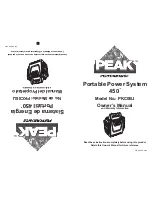
Installation
2. Fuse Selection - As illustrated in the diagram, each positive conductor from the charger to the
battery/battery bank must be fused. Choose a fuse that is 10 amps higher than the charger output
(e.g. 60 amps, choose a fuse of 70 amps). These fuses come in a variety of sizes and types. When
choosing the proper fuse consider the connection to the DC cable (inline types for smaller amperages,
stud and nut connections for larger amperages) as well as the availability of replacements. Fuses
and holders are available through ProMariner or your local marine supply store.
3. Ground - This is extremely important and often overlooked. There is one common battery
ground with the positive battery connections on the ProNauticP. There is also a “Chassis Ground”.
a. Battery Negative - As shown in the diagram, this is connected to a bus bar or terminal stud
(not included) that can handle, at a minimum the amperage of the charger output (1260 =
60 amp minimum). This conductor shall be of equal size to the DC positive conductor chosen
above. The battery negative terminals are connected to this bus bar or terminal stud.
b. Bonding Stud A.K.A Chassis Ground - This stud is connected to the boats bonding system
as well as the bus bar or terminal stud mentioned above. This conductor is permitted to be
one size smaller than the DC positive conductor chosen above; in the case of a DC to the
case fault, this conductor is critical in carrying the fault current to trip the fuse or breaker,
the AC ground CAN NOT handle high DC amperages.
4. Empty Charger Banks - In the event of an empty charger bank there is no need to use a jumper as
done with traditional chargers. Simply leave the DC positive unloaded and the unit will perform correctly.
Remote Temperature Sensor Probe
11
Probe Connections:
Battery End (ring terminal) – Connect to the NEGATIVE terminal of the battery.
Charger End – Attach the “phone” style plug into the charger port labeled “BAT SENSE”.
Note: Once the temperature sensor is connected the charger will adjust its charge based on the
batteries temperature. This is known as thermal compensation, where the charger will cut back
if necessary to increase battery life. This is especially useful for AGM and GEL batteries which
are inherently temperature sensitive.
The ProNauticP comes standard with a
temperature probe that is plug and play. The
temperature probe must be connected while
the charger is powered down or before it is
connected to the breaker during installation.
For best performance, attach the probe to the
negative terminal of the “house” batter/bank
12
Installation
A remote panel is available for your ProNauticP Charger.
The remote is provided with a cable and a network-type plug connector. Pay careful attention
to the routing of the cable. Avoid sources of heat and possible chafe when routing.
With the charger powered down, connect the cable to the Helm Remote port on the ProNauticP.
Optional Remote Installation
Start-up Guide
Check List
Verify AC connections are correct (L,N,G) and secure
Verify DC connections (+,-) are correct and secure
Verify DC protective cover is installed
Connect shore/station power
Turn on main AC breaker
Turn on charger AC breaker
Verify LED’s indicators are correct (see operation section)
Please refer to this section to begin using your installed and configured ProNauticP Series
charger. This section is not detailed and you should be familiar with the rest of the contents
of this manual.
Verify shore power/station is connected and main AC breaker is in the ON position.
Apply power to your ProNauticP Series charger by switching on branch circuit power. The
charger will immediately come on with all LEDs lit while it performs a system check. Once
complete the LED display will resume normal operation as it enters the charging mode,
DC voltage will increase. LED indicators on the charger are as follows:
Power
Fault
Backlight
Alarm
Setup
Enter
Digital
Pro
Mar
Performance Charging
Pro
Ma r i ne r
™
Содержание ProNautic 1210P
Страница 16: ...Notes Notes...


































